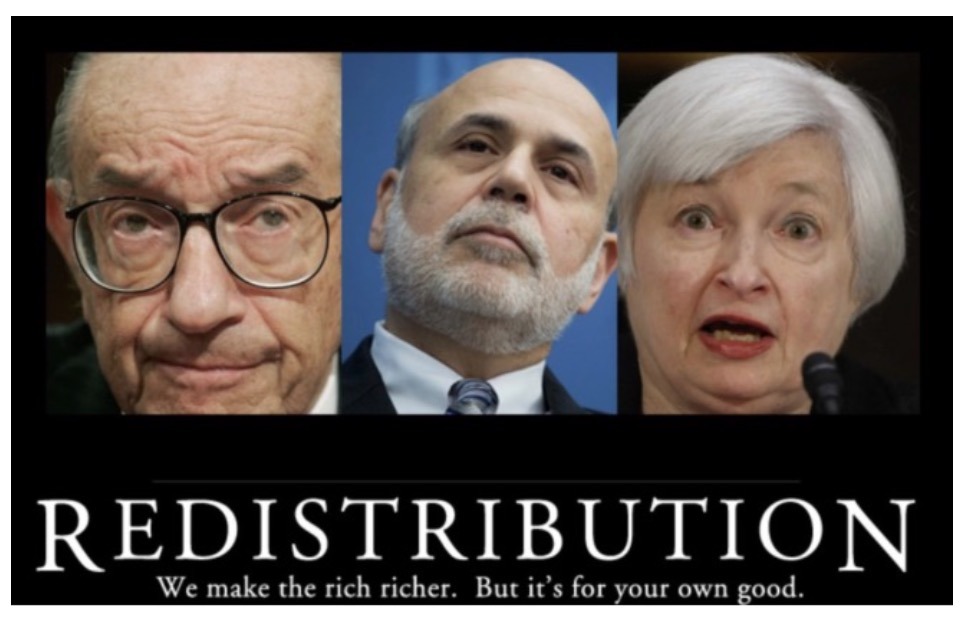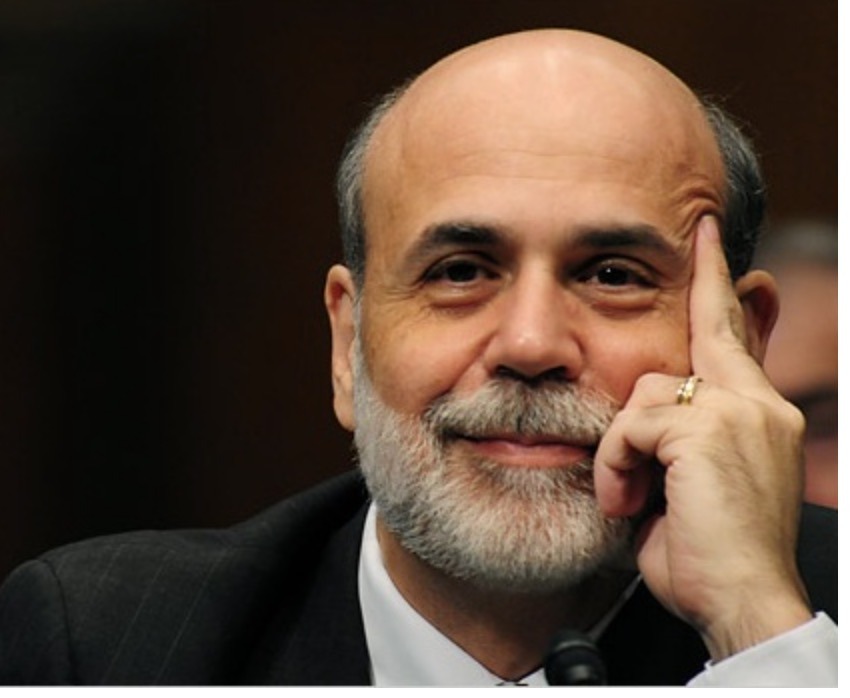
When it comes to the Fed, Congress is mired in hypocrisy. The anti-regulation, de-regulation crowd on Capitol Hill shuts its mouth when it comes to the most powerful regulators of all – you and the Federal Reserve. Meanwhile, Congress goes along with the out-of-control, private government of the Fed—unaccountable to the national legislature. Moreover, your massive monetary injections scarcely led to any jobs on the ground, other than stock and bond processors.
– From the post: Ralph Nader Destroys the Federal Reserve in Open Letter – Calls it “Out of Control, Private Government”
If I had to choose one single institution and one single individual most responsible for the weak, putrid and unbelievably corrupt oligarch-controlled U.S. economy, I would choose the Federal Reserve and Ben Bernanke.
The central planners at the Fed have systematically funneled trillions of dollars into the pockets of those who needed and deserved it least, and in the process served to further enrich and entrench a criminal oligarchy while pounding the middle class into oblivion. What’s worse, the financial armageddon faced thus far by the 99.99% is just getting started.
Thanks to the 0% rate targeted by the Federal Reserve, pensions simply can’t get a decent return without moving further and further out on the asset management risk spectrum, and even then, it’s still not sufficient.
Today’s Wall Street Journal article on the topic shines a much needed light on just how dangerous this whole charade has become. Here are a few excerpts:
What it means to be a successful investor in 2016 can be summed up in four words: bigger gambles, lower returns.
Thanks to rock-bottom interest rates in the U.S., negative rates in other parts of the world, and lackluster growth, investors are becoming increasingly creative—and embracing increasing risk—to bolster their performances.
To even come close these days to what is considered a reasonably strong return of 7.5%, pension funds and other large endowments are reaching ever further into riskier investments: adding big dollops of global stocks, real estate and private-equity investments to the once-standard investment of high-grade bonds. Two decades ago, it was possible to make that kind of return just by buying and holding investment-grade bonds, according to new research.
Thank you, Ben Bernanke.
The amplified bets carry potential pitfalls and heftier management fees. Global stocks and private equity represent among the riskiest bets investors can make today, Mr. Kloepfer said.
Not to mention what often amounts to investing in criminal schemes. Recall: SEC Official Claims Over 50% of Private Equity Audits Reveal Criminal Behavior.
Bonds historically produced a source of safe, good-enough streams of profit that allowed long-term, risk-averse investors to hit annual targets. The era of low rates has all but erased that buffer. The absence of a few extra percentage points of yield means investors must now compensate by embracing unsafe bets that could strike big—or flop. The Callan report highlights how risky an endeavor that is.
Many large investors aren’t gambling that big—and their returns are lagging well behind internal targets. The nation’s largest public pension fund, the California Public Employees’ Retirement System, has one-fifth of its assets in bonds and is down 1.3% since July 1, according to public documents. The system, known by its abbreviation Calpers, also has 53.1% of its assets in stocks, 9% in real estate and 9.4% in private equity. In 2015, Calpers posted a return of 2.4%, below its target rate of 7.5%.
As you can see, they still aren’t getting a decent return despite moving outward on the risk spectrum. On the bright side, at least hedge managers and private equity partners are making a fortune from the exorbitant fees they charge pension funds for poor performance. For example, see:
Additional Details Emerge on How Hedge Funds and Private Equity Firms Loot Public Pensions
“Let Them Sell Their Summer Homes” – NYC’s Largest Public Pension to Ditch Hedge Funds
Pensions and Private Equity – A Letter to the New York Times Editor
The risk dilemma for investors has real-life consequences. Retirement plans, including Calpers and the New York State Common Retirement Fund, are lowering what they predict they can earn on their investments, a move that means workers and cities likely face higher contributions and taxes. For insurers, lower bond returns mean life-insurance policyholders pay more for coverage.
Guess who ultimately gets shafted because of all this? Yep, you guessed it. The average American citizen.
Cheaper borrowing costs generally spur new investments from companies or consumers. But instead, global production is flat or declining, and consumers face stagnant wages that crimp their ability to spend.
Mission accomplished. Thanks for playin’ suckers:

For more on the Creature from Jekyll Island, see:
The Federal Reserve Refuses to Provide Names Requested by Congress in Probe
In Liberty,
Michael Krieger
Donate bitcoins: 35DBUbbAQHTqbDaAc5mAaN6BqwA2AxuE7G
Follow me on Twitter.



that’s it.
http://investmentwatchblog.com/secret-laws-secret-courts-secret-prisons-now-secret-treaties/
Markets to be cut in half between now and Ramadan. Personal debt all time high, taxation all time high, national debt all time high, welfare all time high, real unemployment all time high. Even corporate debt doubled during the 7 years of Soretoro, now passing 7 trillion ALONE. When the default begin there will be no emergency bailouts, they will cascade in less than a single hour.
You are on to something!
Don’t worry when Hillary gets elected the electronic money printing will run amok and the darling Clinton Foundation will soar.
Sorry, Ricardo, Hillary will never be elected. She’s a psychopathic liar, a traitor and a war criminal.
Bernie Sanders supporters won’t vote for the Hildabeast; they’ll either leave out the President/Veep block and just vote for Congress on down, or vote for Bernie as a write-in.
Actually, the libertarian party is the only party that has informed me they, like me, support stopping over sixty-five years of the abusive application of the state secrets privilege and related doctrine, act, executive order, administrative action, regulation, and related policy abuses. Also, the ACLU has their foot in the door on this issue and needs our support.
Why don’t the pension funds just invest in PM’s and sit back and relax ?
Both gold and silver are in the process of reverting to their means of $456 and $8 per ounce respectively and have huge losses dead ahead in this current 22 year downturn which has only been ongoing for 5 years since April 2011 and since then silver has plunged around 68% and gold has plunged around 40%. Are you extremely math challenged or what? No pension fund with any intelligence would put a single penny of funds into extraordinarily volatile and loss ridden commodities junk like those metals. Hellllllooooo?
Criminals
http://www.thecommonsenseshow.com/2016/05/31/this-will-be-the-end-of-humanity-unless-this-is-stopped/?utm_source=rss&utm_medium=rss&utm_campaign=this-will-be-the-end-of-humanity-unless-this-is-stopped
WANTED / HANG ‘EM HIGH
http://financearmageddon.blogspot.com/2016/06/what-666-mark-of-beast-just-got-real.html
The Federal Reserve has done no such thing at all as you assert.
The Federal Reserve has nothing whatsoever to do with the rates paid on savings accounts at US banks. They are keyed off the yields on 3 month US Treasuries which are nearly 0%.
There has never been any regulation or requirement in the US regarding what banks or thrifts (savings and loans) have to pay to depositors on time deposit accounts (savings, CDs, etc.) other than REGULATION Q which was part of the 1934 Glass-Steagall Act.
Regulation Q set a MAXIMUM amount for interest rates that could be paid by banks and thrifts on time deposit accounts but NEVER SET A MINIMUM AMOUNT The maximum amount was 5.00% for banks and 5.25% for thrifts. Regulation Q prohibited banks and thrifts from paying any interest whatsoever on and demand deposit accounts (checking, etc.)
http://en.wikipedia.org/wiki/Regulation_Q
As to interest rates on savings accounts, BANKS ARE AWASH WITH EXCESS CUSTOMER DEPOSITS AT A TIME WHEN DEMAND FOR BORROWING IS VERY LOW which is why interest on savings rates is so low and that is not likely to change much.
In fact, the ratio of outstanding loans at banks (assets) to customer deposits (liabilities) is at a RECORD LOW RATIO OF 67% in the aggregate in the US. Banks do not need to get money from customer deposits so do not want to encourage customer deposits as they would have no way to earn much in the way of income from those deposits to pay account holders.
The days of free toasters and bonus interest rates for savings deposits WILL NOT BE SEEN AGAIN UNTIL AND UNLESS BANKS SEE SUBSTANTIAL DEMAND FOR BORROWING BY QUALIFIED CREDITWORTHY CUSTOMERS.
The rates paid on interest bearing accounts at banks are generally keyed off the yield (interest rate) on 3 month US Treasuries just like the Federal Funds Rate set by the Federal Reserve. Watch that for the direction of interest rates on savings accounts.
The Federal Reserve did not run up a single penny of the federal government debt and 100% of the blame for that goes to Congress and the White House which have together increased the federal debt from $1 trillion in 1981 to over $18.670 trillion presently.
The Federal Reserve annually rebates 94% of its profits to the US Treasury for the benefit of its taxpayers and DOES NOT COST TAXPAYERS A SINGLE PENNY and is, in fact, the largest single entity contributor to US Treasury revenues with a contribution that is nearly $100 billion a year. Are you somehow not aware of that fact?
For a detailed analysis of how the Ponzi scheme Federal Reserve uses the FRBNY’s exclusive control over the auction funds of Treasury securities to embezzle money from the US government, go to https://ppjg.me/2017/11/09/fiscal-bliss-ignorance-is-bliss/